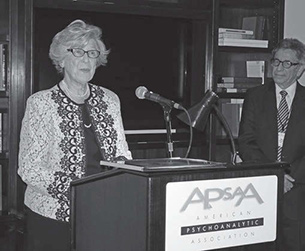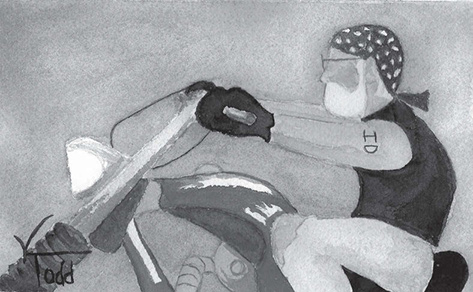Photos by Wylie Tene
Award Winners from the 2016 National Meeting
Candidates’ Council Psychoanalytic Paper Prize
Deborah Weisinger, Psy.D., “Developing a Psychoanalytic Identity in the Presence of a Psychotherapeutic Identity”
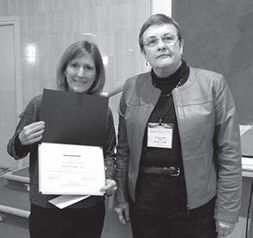
Deborah Weisinger and Phoebe Cirio
Semi-finalist: Suzanne Klein, Ph.D., “Healing Psychic Trauma through the Psychoanalytic Relationship”
CORST Essay Prize in Psychoanalysis and Culture
Gavriel Reisner, Ph.D., for his paper “On Ghosted and Ancestral Selves in Hamlet: Loewald’s ‘Present Life’ and Winnicott’s ‘Potential Space’ in Shakespeare’s Play”
APsaA Schools Committee Anna Freud Educational Achievement Award
Gilbert W. Kliman, M.D., Medical Director of The Children’s Psychological Health Center of San Francisco
Award for Excellence in Journalism
Gabrielle Glaser, The Atlantic, for “The False Prophecy of Alcoholics Anonymous,” which appeared in the April 2015 issue
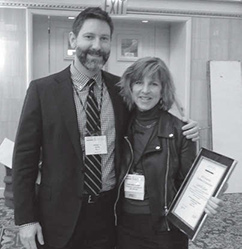
Will Braun and Gabrielle Glaser
Honorary Membership
Daniel Benveniste, Ph.D.
Ilga Svechs, Ph.D.
Helen Meyers Traveling Psychoanalytic Scholar Award
Jennifer Stuart, Ph.D.
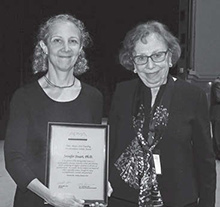
Jennifer Stuart and Nancy Kulish
Poster Session Award
Serge Lecours, Ph.D., Frédérick L. Philippe, Ph.D., Marie-Éve Boucher, Ph.D. cand., Lola Ahoundoval, Ph.D. cand., and Catherine Allard-Chapais, Ph.D. cand. For their poster “Negative self-evaluating emotions as mediator in the relationship between childhood emotional trauma and alexithymia in adulthood”
Edith Sabshin Teaching Awards
John Barnhill, M.D.—Association for Psychoanalytic Medicine and the Columbia University Center for Psychoanalytic Training & Research
Martin A. Ceaser, M.D.—Baltimore Washington Center for Psychotherapy & Psychoanalysis
Andrew Chirchirillo, Ph.D.—St. Louis Psychoanalytic Institute
Miriam Field, MSS, LCSW—Psychoanalytic Center of Philadelphia
Naomi Janowitz, Ph.D.—San Francisco Center for Psychoanalysis
Courage to Dream Book Prize
Kate Schechter, Ph.D., for her book Illusions of a Future: Psychoanalysis and the Biopolitics of Desire (Duke University Press, 2014)
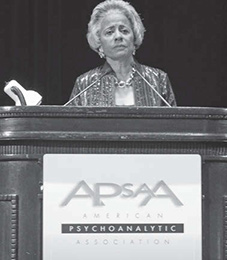
Dorothy E. Holmes
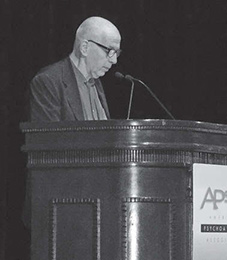
Donald B. Moss
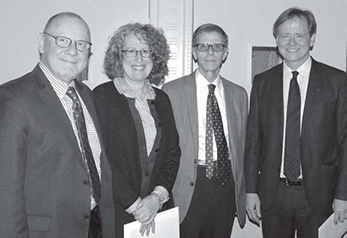
Edith Sabshin Award Winners Andrew Chirchirillo, Miriam Field, Martin A. Ceaser and John Barnhill (Naomi Janowitz not present)
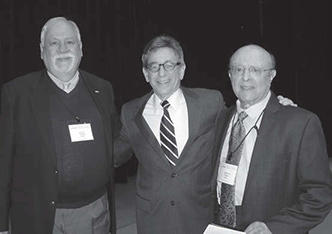
John Tieman, Mark Smaller and Gilbert Kliman
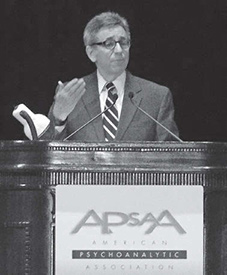
Mark Smaller
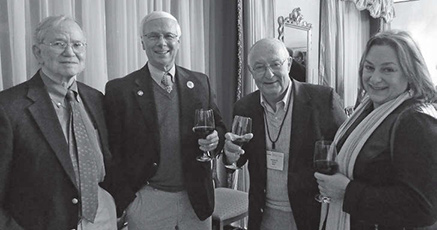
Bob Pyles, Jim Pyles, Herb Gross and Peggy Tighe
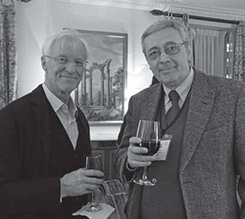
Serge Fritch and Stefano Bolignini
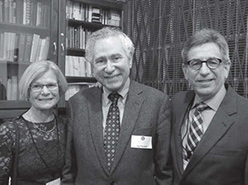
Harriet Wolfe, Jay Kwawer and Mark Smaller
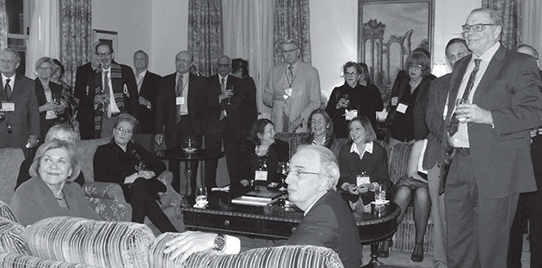
President’s Reception

Plenary audience
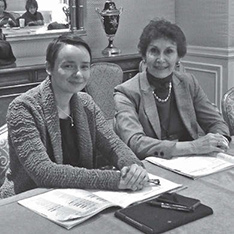
Norka Melberg and Mali Mann
Psychoanalysis Is a Human Tradition Passed On from One Generation to the Next
Daniel Benveniste
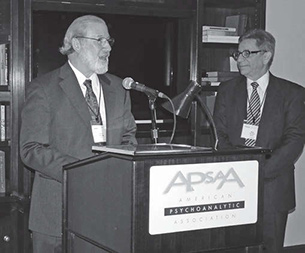
Daniel Benveniste and Mark Smaller
Acceptance speech upon receiving an Honorary Membership
I am delighted this evening to accept this honorary membership in the American Psychoanalytic Association. It is, indeed, an honor and a great pleasure, as well.
When it comes to developing a professional identity, training is essential. But two other ways of further developing that professional identity are through professional affiliation, with institutes and associations, and/or through lineage. Being an outsider all my life has naturally made me incline less toward belonging and more toward lineage. As I like to put it, psychoanalysis is a human tradition passed on from one generation to the next and tonight I find myself thinking of my mentor, Nathan Adler, a psychoanalyst in San Francisco who studied outside the formal institute under Siegfried Bernfeld. And Bernfeld, of course, was an analyst in Vienna who also studied outside the formal institute, under Sigmund Freud.
It was during my five years of clinical supervision with Adler that I became interested in the early history of psychoanalysis in San Francisco. Hearing his stories of Siegfried and Suzanne Bernfeld and the other emigre analysts arriving in San Francisco in the 1930s piqued my curiosity and the next thing I knew I was under the spell of a powerful fascination for the topic. I conducted 80 plus interviews, wrote a number of articles on the topic and analyzed my fascination for the early history of psychoanalysis in San Francisco. What I discovered is that when my mother was pregnant with me, my father’s father, Nissim Benveniste, died. He was 61 years old—my age today—and he had been sick for ten years. He was a good, kind and generous man, beloved by all and his early death left everyone in the family grieving in silence. So I came into the world surrounded not only by the warmth of my family but also in the shadow of this rather significant absent other about whom no one could utter a word. I consequently became fascinated with everything that happened long ago. Imagine my surprise then, when I later discovered my grandfather was born in 1891 and Bernfeld in 1892 and they both died in 1953.
This interest in hearing about what happened long ago was further stoked when W. Ernest Freud, the fort-da baby and the only Freud grandson to become a psychoanalyst, asked me to write his biography. There I was in Heidelberg emotionally motivated by a curiosity about my Grandpa Nissim, while listening to W. Ernest Freud telling me about his Grandpa Sigmund, his Grosspapa.
As Ernest spoke of his grandfather teaching his Aunt Anna about psychoanalysis and his Aunt Anna teaching him about psychoanalysis, I thought of my own lineage from Freud to Bernfeld to Nathan Adler to me. And so it is, that in these ways and many others psychoanalysis is passed on from one generation to the next.
I think it is probably very possible to become an outstanding dentist without knowing the history of dentistry but when it comes to psychoanalysis and psychoanalytic psychotherapy, one’s theory and technique will always broaden and deepen with a greater understanding of the history of psychoanalysis.
The history of psychoanalysis is full of useful lessons for contemporary challenges. I have, for example, a list of 13 major contributors to psychoanalysis who all met Freud, began their training or even finished their training before the age of 29—that’s not 49 or 59—that’s 29! Many people read Freud when they are teenagers or in their early 20s but when no one is there to discuss their concerns, their passions may naturally cool and they may move on to other fields. I think it will serve psychoanalysis if institutes and associations can find ways to invite young people, teenagers and those in their early 20s, to join in the psychoanalytic dialogue and let these young spirits infuse psychoanalysis with their natural curiosity and vibrant creativity.
Another useful lesson from the history of psychoanalysis is the fact that many early psychoanalysts such as Freud, Adler, Deutsch, Fromm, Menninger, Erikson and others all wrote for the public. These days most analysts only write for other analysts, while the public has no other source of information other than the Freud bashers who introduce their misconceptions and denigrations of Freud and psychoanalysis to one generation after another.
If we can write for the public and draw younger people into the field, we will strengthen our discipline and be in a better position to pass the torch of psychoanalysis on to the next generation.
In conclusion, I would like to thank Arnold Richards for recognizing and championing my work; and thank the American Psychoanalytic Association for this honorary membership. It all means a great deal to me and just goes to show that even outsiders like me can find pleasure in belonging. Thank you.
